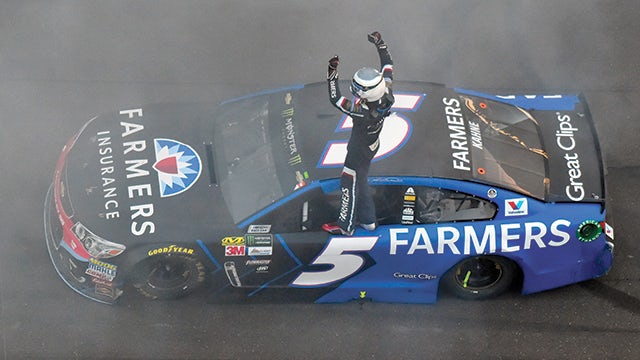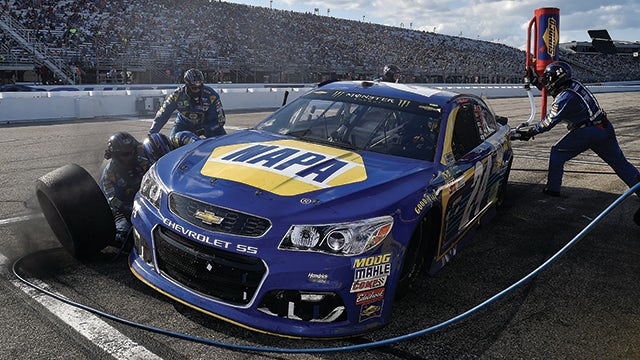Premier NASCAR team uses lessons learned as catalyst for improvement
Hendrick Motorsports leverages Simcenter for forensic failure analysis and developing improved components
Hendrick Motorsports
Since 1984, Hendrick Motorsports has earned a record 10 championships in NASCAR’s premier division, the Sprint Cup Series. The organization fields four full-time Chevrolet teams on the Sprint Cup circuit with drivers Kasey Kahne, Jeff Gordon, Jimmie Johnson and Dale Earnhardt Jr.
http://www.hendrickmotorsports.com- Headquarters:
- Charlotte, North Carolina, United States
- Products:
- NX, Simcenter Nastran, Simcenter Products
- Industry Sector:
- Automotive & transportation
We are using finite element analysis as an upfront tool for the design, so we don’t have to break the part before we improve it.
Hendrick Motorsports
Decoding the mechanics of a failure
Hendrick Motorsports is a critically acclaimed and immensely successful NASCAR® racing outfit. Operating out of a 430,000 square-foot campus in Concord, North Carolina, the team represents an important part of NASCAR history, having won 10 championships in the premier Sprint Cup Series. Its roster of stock car drivers includes Kasey Kahne, Jeff Gordon, Jimmie Johnson and Dale Earnhardt Jr. Hendrick Motorsports’ four Sprint Cup teams are supported by a staff of 500 and a wide array of technologically sophisticated tools, including product lifecycle management (PLM) software from Siemens Digital Industries Software.
Despite the best efforts to ensure the performance of critical systems, component failures are commonplace in motor sports. The balance between the need for more speed (through innovative design and weight reduction) and durability puts almost every part on the edge of failure on every run. It is simply impossible to test or analyze every component under every possible operating condition. Failures that occur during a time trial, practice round or race are just a fact of life on the track. This is particularly true for race teams that are constantly pushing the limits, trying out new ideas and approaches to gain a competitive edge.
Although Hendrick Motorsports understands that failures are an inevitable part of competitive racing, they are determined to learn from them: “We don’t make the same mistake twice,” says Jim Wall, director of engine engineering.
To that end, Hendrick Motorsports utilizes Siemens Digital Industries Software’s NX™ software for its product development needs. For computer-aided design (CAD) and computer-aided engineering (CAE), Hendrick Motorsports employs NX CAD, NX CAE and Simcenter Nastran® software. The forensic analysis of failed parts is particularly important. The idea is to transform inevitable component failures into lessons learned and applied.
“The ability to turn designs into real hard parts is critical for us, and the NX suite helps support every facet of that,” notes Wall.
To gain an understanding of a part failure, the team first recreates the failure analytically so the model can be validated against the failed physical component. The validated model is then used to fundamentally re-engineer the part to prevent the failure while still maintaining the design intent. This approach is leading to some creative yet practical solutions to failures experienced on the race track.
Enabling quick fixes
The benefit of the approach with NX CAE is that part fixes can be validated virtually, meaning that prototype testing can often be avoided, saving precious time. Additionally, the tight integration between NX CAD and NX CAE accelerates the evaluation of numerous solution proposals, as changes are pushed directly and seamlessly from the CAD part to the CAE model. This is particularly crucial during race season, when the team has mere days to react to a track failure before the next competition.
“Our product release cycle can be as short as three days,” explains Wall. “If we have a failure on Sunday, we’ve got to come up with a fix, produce parts and retrofit the fleet, usually before Wednesday night when the trucks get loaded with the race cars for next weekend’s event.”

Redistributing the load
During a routine post-race inspection of rear suspension parts after the Talladega 500 in May, 2012, a race that involved speeds up to and over 200 miles per hour (mph), yielding was observed on the rear housing saddle assembly as well as the trailing arm channel. (Yielding refers to the metal permanently deforming or cracking.)
“We were concerned and decided to investigate a solution with NX CAE,” says Charles MacDonald, a design engineer for vehicle engineering. “A baseline model was built to visualize the yielding, and this also served to correlate the model and the results against their physical counterparts. Once validated, we used the model in a predictive context to evaluate potential solutions to the yielding that was observed.”
Using NX CAE, a number of potential solution areas were identified for exploration. When these changes resulted in localized improvements, but not a complete problem resolution, they were eliminated as options. One idea that was proposed finally yielded promising results.
“We decided to try adding a cone shape to the crush sleeve,” explains MacDonald. “We modeled it up using NX and updated the CAE model with a few mouse clicks before using Simcenter Nastran to solve the model. Results proved that the cone shape helped redistribute the load sufficiently to prevent yielding. We had found our solution. This solution was rapidly adopted by the fleet for the remainder of the season.”
Unraveling the cause of engine failures
Another case of failure analysis and redesign involved engine valve springs, a rather innocuous component that is often not considered in detail. Valve springs are a critical component of an engine’s gas exchange system. Due to the high-cycle nature of engine intake and exhaust events, these components need to be designed and engineered for high-fatigue life. When Hendrick Motorsports had multiple engines fail during the course of the 2012 season, it was critical to identify the cause and resolve it as quickly as possible.
“Spring design is typically driven by basic equations that characterize forces and stresses internally to the part, but do not provide insight into the location of these stresses,” explains Bryan Fleck, engineering analyst at Hendrick Motorsports. “On the other hand, by using CAE tools, it is possible for a spring designer to assess the stress at any location within the spring, providing insight for future design.”
Using NX CAE, Hendrick Motorsports was able to examine the variation of stress throughout the spring coil.
“The use of NX CAE simulation tools was valuable in providing insight into the deformations and locations of stresses in a valve spring,” says Fleck. “It was this critical understanding that helped us re-engineer springs that wouldn’t fail during the punishing duty cycles that our engines are subjected to on the speedway.”
Repeated failure is not an option
Forward engineering of motorsports components is a major focus at Hendrick Motorsports. The objective is to design the best possible component from the start, taking failure risk out of the equation while maximizing performance potential.
“In the last decade we have been moving forward with a more optimal design from the concept stage,” says Wall. “We are using finite element analysis (FEA) as an upfront tool for the design so we don’t have to break the part before we improve it. We want to engineer components that allow our teams to showcase their talents to the best of their abilities.”

Designing with confidence
By focusing on forward-engineering parts with an analytical approach, Hendrick Motorsports is producing precisely engineered parts that help mitigate the practice of over designing parts to avoid failure. This keeps additional weight off the car. Use of NX CAE allows engineers at Hendrick Motorsports to better balance component strength with weight, getting them closer to the optimal marriage of durability and performance sought by every race team.
Providing the tools for victory
With NX CAE in place, Hendrick Motorsports is unraveling the causes of failures faster than ever, while developing effective, first-time-right fixes to these failures. An extensive prototype part testing and trial-and-error approach has been replaced by upfront, analysis-led design. The results are high-performing, forward-engineered components, timely solutions to track failures and a continuation of a winning tradition. That’s the reward for paying attention to lessons learned.
We decided to try adding a cone shape to the crush sleeve. We modeled it up using NX and updated the CAE model with a few mouse clicks before using Simcenter Nastran to solve the model. Results proved that the cone shape helped redistribute the load sufficiently to prevent yielding. We had found our solution.
Hendrick Motorsports
